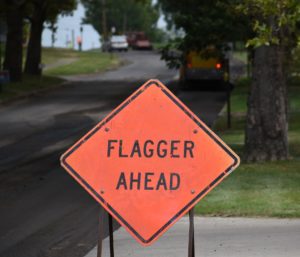
FACTS
- Flaggers and other highway maintenance workers should wear highly-visible clothing, so they can be easily seen by coworkers and motorists. New technologies, such as automated flagger assistance devices (AFADs), can help prevent injuries by taking people out of the equation. AFADs are controlled by a remote, which keeps the flagger out of immediate danger from oncoming traffic.
- Hazards on the road construction site originate from two main sources: construction machinery and roadway traffic.
- Flagpersons, also known as ‘flaggers’ or ‘signallers’, work on the boundary at which the main sources of threat intersect, co-ordinating safe interactions between machinery, construction crews and public traffic.
- The main role of the flagger is to ‘reduce the speed of the traffic through the work zone for the protection of the work crew and motorist.
- Flaggers are often being the first worker seen at a construction site. Besides co-ordinating traffic, flaggers often provide information about the work being done or inform motorists
- The flagperson is responsible for the safety of themselves, their crew, the motoring public and construction traffic.
STATS
- According to the Bureau of Labor Statistics, 73 % of fatal injuries in work zones were from transportation vehicles. Of these fatalities, 61 % of workers were struck by vehicles inside the work zone.
- British Columbia reports 8 flagperson fatalities with 325 disability claims made by flagpersons.
- Between 2011 and 2020, 12 roadside workers were killed and 207 were injured resulting in time loss in B.C
- Last year, 23 flagpersons were injured because of being hit by a motor vehicle.
- 15 roadside workers killed, hundreds injured over 10 years. About half of those injured were traffic control or flag persons.
- 15 roadside workers have died and 229 have been injured after they were hit by vehicles while on the job.
- A minimum of 54 (6%) of these pedestrian fatalities were flaggers or surveyors. Flaggers accounted for half the 34 pedestrian fatalities among women, compared with only 3% among men.
